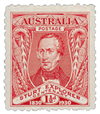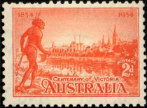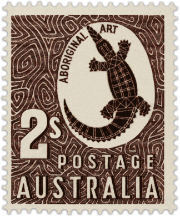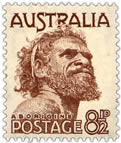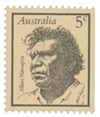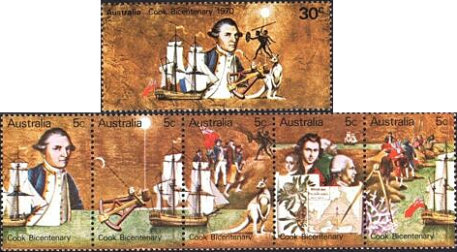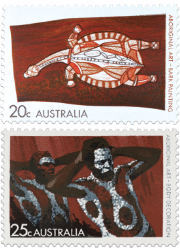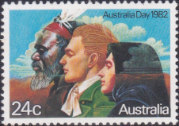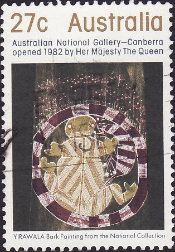Aboriginal timeline: Arts
Found 131 results for your search. Showing page 1 of 7.
1620
-
The oldest dated rock painting is believed to come from the 1620s. The rock painting depicts a sailing boat and is proof of Aboriginal people’s early contact, possibly with Macassars from Indonesia fishing for trepang [1].
1903
-
Tasmanian Aboriginal woman Fanny Cochrane Smith is recorded singing in her native tongue, the first and only recording of Tasmania’s Aboriginal language.
1930
-

1930: Can you find all elements in the stamp? The first stamp of Australia showing a reference to Aboriginal culture celebrates the centenary of Exploration of Murray River (1½d red and 3d blue). It shows a boomerang, a coolamon, two spear heads and Lyre bird tail feathers.
1934
-

One of the earliest Australian stamps with a reference to Aboriginal culture. The 1934 stamp issue shows an Aboriginal man with spears walking towards a river that separates him from the town beyond, almost as if to show the contrast between pre and post invasion conditions. There were three denominations to the set.
1938
-
Central Australian Aboriginal painter, Albert Namatjira, holds his first exhibition in Melbourne. All 41 works are sold in three days. He combines European painting techniques (mainly watercolours) with subject matter from his native land.
1948
-

Designed by a non-Aboriginal artist, this 2-shilling stamp is the first to show an Aboriginal art theme. Australia Post releases the first Australian stamp that features an Aboriginal art theme. The 2 shilling stamp represents a crocodile in the style of a rock painting and is part of the Australian Animals definitive stamp issue of that year. But the artist, Gert Sellheim, is not Aboriginal.
1950
-

Gwoya Jungarai The portrait of Gwoya Jungarai (c.1895-1965, also spelled Tjungurrayi or Djungarai) of the Warlpiri people, Central Australia, appears on the 8 1/2 pence (8 1/2d) and two shillings and sixpence (2s.6d, issued 1952) definitive stamps. It is the first time a living Australian — settler or Aboriginal — is featured on a stamp.
The stamps become widely known as “One Pound Jimmy” because when asked the price of his artefacts for sale Gwoya always replied “One Pound”. Tjungurrayi was a stockman, traditional lawman, and survivor of the brutal 1928 Coniston massacre. His portrait is later engraved on the two dollar coin.
1955
-
Melbourne stages its first Moomba festival. Approached about naming the festival, Aboriginal people suggest “Moomba”, telling the officials it means “Let’s get together and have fun!” Actually meaning “up your bum” the name was adopted and is still used.
1964
-
Oodgeroo Noonuccal (Kath Walker) becomes the first Aboriginal Australian to publish a book of verse. She goes on to become one of the best known and most respected authors in Australia and overseas.
-
The Legends of Moonie Jarl is the first Aboriginal children’s book published in Australia. It is also the first Aboriginal children’s book in schools. It is republished more than 50 years later, in 2015.
1968
-
Desecration of the Weebo sacred site in central Western Australia through pegging of mineral claims eventually leads to the Western Australian Heritage Act being proclaimed in 1972.
-
First Aboriginal debutante ball at Sydney Town Hall. Prime Minister John Gorton was one of the guests.
-

Stamp celebrating Aboriginal artist Albert Namatjira. First named Aboriginal person honoured on an Australian stamp. Artist Albert Namatjira appears on the Famous Australians issue. He was also the first Aboriginal person to be accepted as a citizen of the Commonwealth in 1957.
1970
-
A stamp issue for Australia's 200th anniversary of "first European contact" at the east coast centres around Captain Cook. A mini sheet issued by Australia Post annotates the third stamp of the series (which shows Aboriginal people in the top right corner) with "where he finds new people and strange animals", conveniently omitting conflict.

The Bicentenary issue put Aboriginal people into the far background. Can you spot them?
1971
-
Jack Charles and Bob Maza found the first Aboriginal theatre company Nindethana.
-

The first issue showing Aboriginal art did not mention the artist but avoided culturally sensitive material. Australia Post releases the first stamp issue to focus on traditional, authentic Aboriginal art forms, titled "Aboriginal Art". While focusing on traditional arts forms, the stamps does not yet name the artist (which started with the 1988 issue).
The 20c design is based on a bark painting of a long necked tortoise from Western Arnhem Land; the 25c, was based on a photograph by Australian anthropologist, Sir Baldwin Spencer (see below); the 30c shows rock paintings of a cave in the Oenpelli area of Western Arnhem Land; the 35c depicts grave posts used in mourning ceremonies on Bathurst & Melville Islands.
The 25 cent stamp shows body decoration used in the final mourning ceremony by the Warramunga people, from the Tennant Creek area in the Northern Territory. The image shows two men in the act of painting each other, which the Warramunga people considered a sacred ceremony to be only witnessed by men. The artist changed the final design so women can also view it. [2]
1972
-
Bruce McGuinness and Martin Bartfeld shoot “Blackfire” which focuses on Aboriginal communities in Melbourne. It is the first film known to have been made by an Aboriginal Australian.
1978
-
Galarrwuy Yunupingu, a leader of the Yolngu tribe in the Northern Territory, receives the Australian of the Year award. ⇒ Famous Aboriginal people
1982
-

The Australia Day 1982 stamp tried to convey a sense of unity of diverse Australians. A stamp for Australia Day shows the head of an Aboriginal man, along with that of a European colonist and an immigrant. The stamp's design symbolises the three waves of migration to Australia: Aboriginal people from south-east Asia, the British and European post-war immigrants.
-

The stamp shows Gurgurr the Moon man, and his dog Mulutji. Australia Post issues a stamp commemorating the opening of the National Gallery, Canberra. The design shows an Aboriginal bark painting of Gurgurr the Moon man, and his dog Mulutji as they appear on the moon. The artist is not mentioned.
References
View article sources (0)
[9244] 'Rock art shows early contact', Sun Herald 18/7/2010
[106871] 'Aboriginal artwork represented on stamps', Australia Post 26/10/2017
